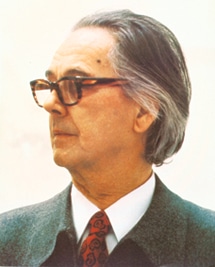How Visionary Victor Vasarely Created the Op Art Movement
As an artist, Victor Vasarely turned quite late to his destiny.

1906–1997
Born in 1906 in Pécs, Hungary, Victor Vasarely is one of the creators of Kinetic and Op Art. Before immigrating to France in 1930, Vasarely attended Mühely, the Academy of Painting based on the teachings of the Bauhaus, in Budapest in 1929. It was during this time that he painted Blue Study and Green Study (1929). In his early works, he explored Symbolism, Post-Cubism, Surrealism and Gestural Painting.
When he first arrived in Paris in 1930, Vasarely began working commercially at Havas advertising agency and then at Draeger, one of the most renowned print houses. 1929-1946 was known as Vasarely’s “Graphic” period. During this time, he created The Zebras (1938), Chess Board (1935), and Girl-Flower (1934). Vasarely was deeply concerned with light, shadow, contrast, and outline. Through this period, two dimensional weight and contrast was explored, beginning to define the dominant style that he would develop over the rest of the century.
From 1935 to 1947, a period which Vasarely calls “my false routes,” he became influenced with many of the popular movements, especially Surrealism and Cubism. This early period of his was one of the only times Vasarely would go figurative, painting the human form in portraits and even translating his ideals to still lifes and genre paintings. He painted Self Portrait (1941) and The Blind Man (1946) which, although figurative, move towards Vasarely’s more signature style and a more simplified version of his perspective.
Dubbed the “Belle-Isle” (Belle-Île) period after his favorite vacation spot in France, between 1947 and 1958, Vasarely truly reached abstraction for the first time. This was a very geometric period for the artist, heavily based on the shape of the oval, inspired by the pebbles on the beach of Belle-Île.
From 1948 to 1951, Vasarely focused on contrast more than before. From a flat perspective, he was able to blaze the trail to kineticism, applying contradictory colors to create movement within a composition. In this period, his most suggestive work was Homage to Malevitch (1952-1958).
The artist’s “Black and White” period was from 1950 to 1965, developing the basic ideas inherent to the creation of Op-Art through the use of only these two colors. Throughout the 1950s, as kinetic art flourished in Paris, Vasarely continued to research, publishing his “Yellow Manifest.” This would be the precursor to his ideas regarding the Fine Arts Alphabet (alphabet plastique) that would attempt to turn the realm of the visual arts into a universal language that everyone could understand. He was most excited to define this alphabet, incorporating this language within popular culture of architecture and urban planning.
In 1965, he participated in the “Responsive Eye” exhibit at the New York Museum of Modern Art. This exhibition was publically dedicated exclusively to “Optical Art,” redefining the relationship between the spectator and work of art, communicating in an entirely abstract and subjective manner. Throughout the seventies, the artist pushed through multiple transitions in his art, cultivating an entirely new perspective for his paintings and graphic works. He focused on the spherical presence within each composition and the presence within the special plane, incorporating color and repetition to create his desired visual effects, and ultimately, a connection to the greater universe.
Vasarely was known as a visionary. He combined techniques in science, architecture, painting, and movement, breeching disciplines and creating a style that would change many of the principals of modern art. Vasarely once said, “all architects, painters, sculptors must learn to work together. It is not a matter of negating the masterpieces of the past but we have to admit that human aspirations have changed. We must transform our ancient way of thinking and conceiving art. Particularly in the cities, we must share it… make it accessible to all. Art must be generous.”
It’s no surprise that Cezanne was Vasarely’s role-model and inspiration. Building his foundation more than a century later in 1976 in Aix-en-Provence, where Cezanne lived and painted, may have been a happy coincidence. They were two farsighted men, changing the facets of modernity once again. A superb graphic artist, Vasarely studiously developed his techniques before he even began painting. His prints reveal the quality of his artistry since his first published print in 1949. He has been widely exhibited throughout the world and has had more than one hundred one-person shows. There have also been over one hundred commissioned monumental architectural works created by Vasarely. March 15, 1997 was the day that Vasarely finally passed, living to the age of 91.
for breaking news, artist updates, and special sale offers